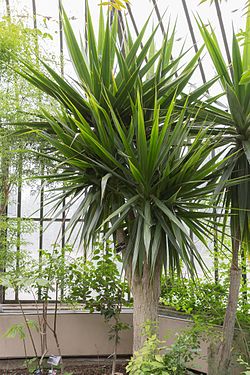| Dracaena arborea | |
|---|---|
 | |
| At the Jardin botanique de Lyon | |
 | |
| Fruit | |
| Scientific classification | |
| Kingdom: | Plantae |
| Clade: | Tracheophytes |
| Clade: | Angiosperms |
| Clade: | Monocots |
| Order: | Asparagales |
| Family: | Asparagaceae |
| Subfamily: | Convallarioideae |
| Genus: | Dracaena |
| Species: | D. arborea |
| Binomial name | |
| Dracaena arborea | |
| Synonyms [1] | |
List
| |
Dracaena arborea, the tree dracaena, is a species of flowering plant in the family Asparagaceae, native to western and west-central wet tropical Africa. [1] It is used as a street tree in a number of African and Brazilian cities. [2]